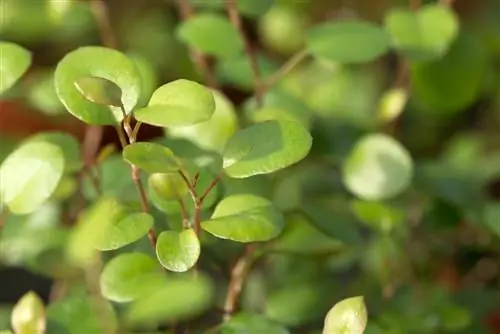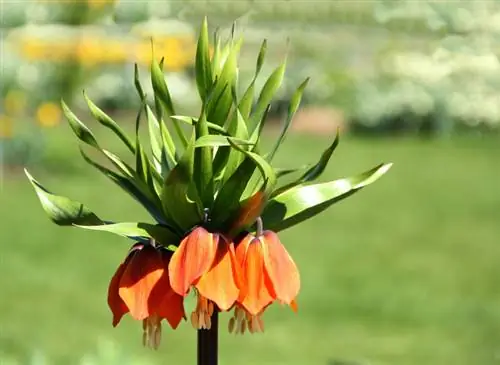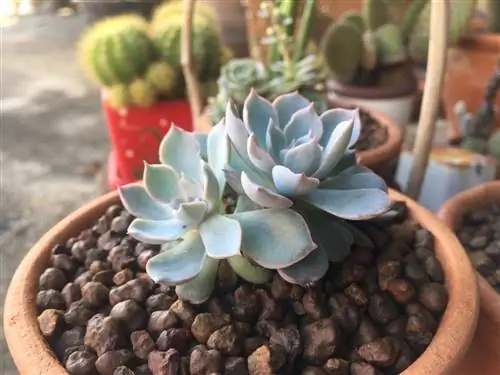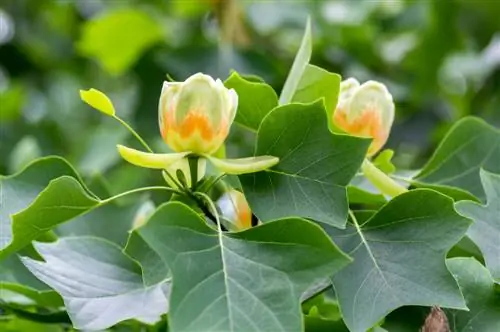- Author admin [email protected].
- Public 2023-12-25 17:45.
- Last modified 2025-01-23 11:21.
Mühlenbeckia species are popular shrubs that are often planted outdoors. But not every representative of this genus is suitable for the conditions of Central Europe. The plants originally come from completely different climate zones. Each species has adapted its growth habit to different climatic conditions.
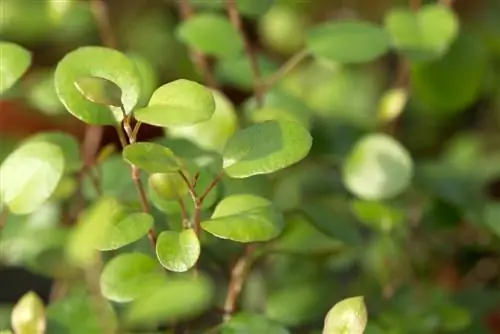
What are Mühlenbeckia and how do you care for them?
Mühlenbeckia species are deciduous, climbing or flat-growing shrubs native to Australia, New Zealand and South America. Popular varieties such as Muehlenbeckia complexa and Muehlenbeckia axillaris are suitable for ground cover, hanging baskets or as houseplants. Care includes partial shade, well-drained soil, regular watering and fertilizing.
Origin
Mühlenbeckia is a genus of plants that contains more than 20 different species. Their main distribution area extends from Australia to New Zealand. They occur in New Guinea and are mainly distributed in the Neotropics. Some species grow in South America. Mühlenbeckia species are also known as wire bushes. The most commonly used ornamental plant is Muehlenbeckia complexa, which is known in German by the common name Mühlenbeckia.
leaves
The leaves of the species are arranged alternately. In most representatives they are divided into a petiole and a leaf blade. Its leaf blade is linear or circular with an attached tip. They can be triangular to lanceolate. The leaf edge is slightly wavy or smooth. At the base of the stem there are either tiny stipules or a cover developed from the stipules, which is transparent and usually falls off at an early stage of development.
Leaf shape of Muehlenbeckia complexa:
- round to egg-shaped
- glossy green
- excited
- stemmed
Bloom
Mühlenbeckia species bear terminal or lateral inflorescences that appear spiked or tufted. The wire bushes develop hermaphrodite flowers. Some plants produce both bisexual and unisexual flowers on one individual. The small, inconspicuous individual flowers consist of a whitish to greenish colored perianth. It is made up of five flower bracts that have grown together. Petals are not developed. The male stamens often appear yellow or pink to purple.
Growth
The plants grow as deciduous shrubs that can adopt upright, prostrate or climbing growth forms. They develop dense branches and an underground rhizome. The branches are very thin and can be downy, glandular or glabrous. Their bark is dark colored.
Usage
Due to the different growth forms, Mühlenbeckia species have numerous possible uses. They are ideal as ground cover and add greenery to unsightly areas in the garden. The bushes can be used to plant hanging baskets. Here they are suitable for the outside area because the branches hang sprawling over the edge of the pot. The climbing species decorate trellises and gates. Upright growing specimens can beautify entrance areas and balconies as potted plants.
Wire bushes are used to provide extensive greenery for rock gardens or to decorate graves. In small gardens they are cultivated as a lawn replacement. Some species are suitable for cultivation in side bowls. Wire bushes can also be cultivated as houseplants.
Groundcover
Not every Mühlenbeckia is suitable as a ground cover. Muehlenbeckia complexa (white-fruited wire bush) and Muehlenbeckia axillaris (black-fruited wire bush) are prostrate shrubs whose branches creep flat over the ground. While the wire vine is only hardy to a limited extent and should be overwintered in a frost-free place if possible, the black-fruited wire bush is also suitable for areas with frosty winter months. This ground cover can easily overwinter outside.
You should pay attention to this:
- light partial shade
- permeable soil with sand content
- Radical pruning possible with a lawnmower
read more
Houseplant
Muehlenbeckia complexa and Muehlenbeckia axillaris are considered popular houseplants. Their climbing shoots decorate hanging hanging baskets or pots equipped with climbing aids that are placed in an elevated location. The wire wine feels particularly comfortable in the room as it requires mild temperatures, mainly in winter. An airy and bright location can promote flower formation. Avoid a location in direct sunlight. A bright spot in partial shade is more suitable. A cool and well-ventilated room ensures he althy growth.read more
Is Muehlenbeckia poisonous?
The plant parts and berries of the wire bushes are considered non-toxic. There are no known indications of intolerance. However, you should discourage children from eating the fruits, as little is known about the ingredients of these plants. No negative effects have been described in animals after consuming leaves and fruits. The green leaves are eaten in small quantities by chinchillas. Muehlenbeckia hastulata is a popular variety on the menu for guinea pigs.read more
Which location is suitable?
Wire bushes prefer a location with moderate to good light. They like a partially shaded spot with bright conditions. Too much sun damages the bushes. Mühlenbeckia species are adaptable and thrive in the shade even in warm places. The plants feel just as comfortable outdoors as they do in a well-ventilated room. In winter, Muehlenbeckia complexa requires temperatures between five and ten degrees Celsius. Muehlenbeckia axillaris is frost hardy.read more
Floor
The soil should be well-drained because the shrubs don't like wet feet. Make sure the root ball is kept evenly moist. An airy potting soil is recommended as a substrate. A mixture of potting soil and sand is ideal. Alternatively, perlite is suitable to increase permeability. The substrate should be pH neutral.
Propagate Muehlenbeckia
Mühlenbeckia species can be propagated by seeds or cuttings. When sowing, a soil temperature of around 20 degrees Celsius is necessary so that the seeds germinate. A heated greenhouse is ideal for this method because it allows you to better control the conditions. If you have a mini greenhouse, you can place it on the windowsill. You can get seeds from specialist retailers or from your own plant (€5.00 on Amazon).
Propagation from cuttings is easier than the seed method. Cut the shoot tips off the plant so that the cuttings have at least three leaves. Place the cut shoots in a planter filled with potting soil and place a transparent plastic bag over the pot. This ensures high humidity. You should moisten the substrate regularly so that it does not dry out. Ventilate the planter daily to prevent mold from forming. In a bright and warm place with temperatures between 20 and 25 degrees Celsius, the cuttings will form their first roots after a few weeks.
Tips for propagating:
- several cuttings in one pot for particularly dense arrangements
- The plant can be divided in spring
- Propagation of cuttings indoors all year round
read more
The correct planting distance
Make sure that there is a distance of 20 to 30 centimeters between two specimens. There is space for ten to twelve plants per square meter. Smaller specimens can be planted more densely with 20 plants per square meter.
What is the best time to plant?
Wire bushes can be planted between February and October. Please note that young plants of winter-hardy varieties and species react sensitively to sub-zero temperatures. For freshly planted plants, a thick layer of insulation is recommended in the first year. In particularly cold winter months, you should also protect outdoor plants with brushwood or pine branches in the following years.
Watering Muehlenbeckia
Ensure regular watering to keep the root ball evenly moist. In a particularly warm location, regular watering is important. Make sure that the soil of potted plants does not dry out. Outdoor shrubs need new watering when the top layer of substrate has dried out. If the plant is too dry, it will lose its leaves. Waterlogging damages the roots. Before planting, ensure a well-drained substrate. In winter you should reduce watering. Give the plants enough water to prevent the root ball from drying out.
Fertilize Muehlenbeckia properly
In the growing period between April and October, wire bushes enjoy regular fertilization that provides them with nutrients. Fertilize the plants about once a month. A liquid fertilizer that you mix with the irrigation water is ideal.
At the beginning of spring or shortly before summer, you can alternatively supply the bushes with a slow-release fertilizer. This gives the plants nutrients until autumn. If you have recently repotted your wire bush, you can mix some compost soil into the substrate. This means you don't have to additionally fertilize the plant for the first few months.
Cut Muehlenbeckia correctly
As soon as some shoots disrupt the overall appearance of the wire bush, you can cut the plant back. Houseplants can be pruned all year round. Outdoor shrubs should be pruned in autumn. Powerless and colorless shoots on which no leaves grow usually arise in winter in locations that are too dark. Remove these branches in spring. They rob the plant of additional energy. If you discover additional dried or diseased shoots during the year, you can cut them off immediately.
To avoid unnecessary injuries during this care procedure, you should use a clean and sharp knife. Mühlenbeckia species prove to be very well tolerated by cutting. Large areas that are overgrown by ground cover plants can be cut off with a lawnmower if necessary. This stimulates densely branched growth. The ideal time for this measure is spring. Set the lawnmower to the highest setting.read more
How do I transplant correctly?
Houseplants should be repotted every one to two years. Mühlenbeckias are fast-growing shrubs that root through the pot substrate within a short period of time. You will then need a larger planter so that your growth does not suffer from the lack of space. The ideal time for transplanting is in spring, as soon as the flowers have faded.
Wintering
Each Mühlenbeckia species is differently adapted to the winter conditions. There are some species that can survive freezing temperatures without any problems. Other representatives within this genus must be overwintered in a frost-free place. If you are not sure which species you have, you should overwinter the shrub in a cool place indoors to be on the safe side.
Muehlenbeckia axillaris is one of the frost-tolerant wire bushes that can survive low temperatures below zero. Protect the plant with a layer of brushwood or pine branches. Muehlenbeckia complexa does not tolerate sub-zero temperatures. This wire bush is not suitable for outdoor cultivation. Planting in a pot allows you to quickly relocate as soon as winter is around the corner. A frost-free winter quarters is important. Before transporting, you should shorten the plant slightly.
Make sure that the root ball does not dry out. On frost-free days you should water the bushes outdoors. Potted plants are watered regularly as soon as the substrate dries out. Fertilization is not necessary during the winter months.read more
Diseases
Wire bushes are extremely robust plants that are not affected by diseases or pests. Damage to the plant can be traced back to incorrect care measures or unsuitable locations. In places that are too dark in winter, the leaves do not receive any light. The lack of light causes the bushes to lose their leaves. If the roots are too wet, they tend to rot. Rotten roots can no longer absorb water, which can also lead to leaf loss.
Make sure the soil has good permeability. Mix the substrate with sand and, if cultivated in a container, ensure good drainage using broken clay or expanded clay. No water should remain in the saucer after watering. Use a clean and sharp tool when cutting, as cuts serve as entry points for pathogens.
Loses leaves
As deciduous species, the shrubs growing outdoors drop their leaves shortly before winter. In spring the plants sprout again and develop fresh foliage. Not all Mühlenbeckia species are equally frost hardy. When the ground freezes, the roots are damaged. The plant is then no longer able to sprout fresh leaves.
If the leaves of a houseplant suddenly turn brown and fall off, this indicates a suboptimal location. Mühlenbeckias need an airy and bright location. The optimal temperatures are between 20 and 25 degrees Celsius. A place on the windowsill that is too hot will cause the leaves to dry out. Due to the dense foliage, the water requirement is very high, especially in summer. You should check the soil moisture daily and water the plant thoroughly. Otherwise there is a risk that only the upper layer of soil will be moistened and the water will not penetrate to the root ball.
Temperature and lighting conditions also play an important role during wintering. If the plant is in a place that is too dark, there will be a lack of light. The plant cannot photosynthesize and sheds its leaves. As a first aid measure, we recommend moving it to another location. Normally the bushes quickly regenerate from the loss of leaves and sprout again.
Tip
Wire bushes create a nostalgic charm. Its creeping shoots are colored dark brown and shimmer slightly dark red in the light. The bright green, shiny leaves form the ideal contrast to the bark. The shrubs are perfect for planting in hanging pots.
Varieties
- Autumn Magic: Develops large leaves and strong shoots. Grows up to 50 centimeters high. Suitable for a sunny location.
- Maori(R): Creeping to drooping shoots. Conditionally hardy.
- Muehlenbeckia axillaris: Flat-growing ground cover. Small round leaves change color in autumn. Grows between five and ten centimeters high. Hardy.
- Muehlenbeckia complexa: Ground cover, suitable as a houseplant. Small leaves on wiry branches. Grows up to 15 centimeters high. Not hardy.

